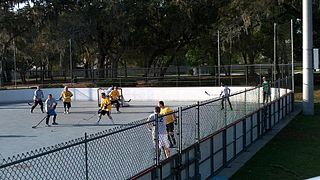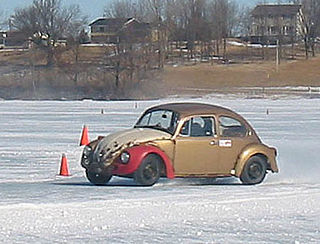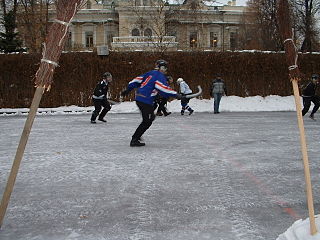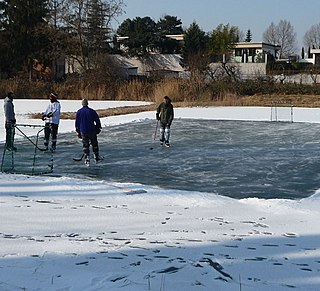
Bandy is a team winter sport played on ice, in which skaters use sticks to direct a bandy ball into the opposing team's goal.
Hockey is a sport in which two teams play against each other by trying to manoeuvre a ball or a puck into the opponent's goal using a hockey stick. There are many types of hockey such as bandy, field hockey, ice hockey and rink hockey.

Ice hockey is a contact team sport played on ice, usually in an indoor or outdoor rink, in which two teams of skaters use their sticks to shoot a vulcanized rubber puck into their opponent's net to score goals. The sport is known to be fast-paced and physical, with teams usually fielding six players at a time: one goaltender to stop the puck from going into their own net, two defensemen, and three forwards who skate the span of the ice trying to control the puck and score goals against the opposing team.

Winter sports or winter activities are competitive sports or non-competitive recreational activities which are played on snow or ice. Most are variations of skiing, ice skating and sledding. Traditionally, such games were only played in cold areas during winter, but artificial snow and artificial ice allow more flexibility. Playing areas and fields are comprised of either snow or ice.

Five-pin bowling is a bowling variant which is played in Canada, where many bowling alleys offer it, either alone or in combination with ten-pin bowling. It was devised around 1909 by Thomas F. Ryan in Toronto, Ontario, at his Toronto Bowling Club, in response to customers who complained that the ten-pin game was too strenuous. He cut five tenpins down to about 75% of their size, and used hand-sized hard rubber balls, thus inventing the original version of five-pin bowling.

Ten-pin bowling is a type of bowling in which a bowler rolls a bowling ball down a wood or synthetic lane toward ten pins positioned evenly in four rows in an equilateral triangle at the far end of the lane. The objective is to knock down all ten pins on the first roll of the ball, or failing that, on the second roll.

Candlepin bowling is a variation of bowling that is played primarily in the Canadian Maritime provinces and the New England region of the United States. It is played with a handheld-sized ball and tall, narrow pins that resemble candles, hence the name.

Street hockey is a variation of the sport of ice hockey where the game is played outdoors on foot, or with inline or roller skates using a ball or puck. Both ball and puck are typically designed to be played on non-ice surfaces. The object of the game is to score more goals than the opposing team by shooting the ball or puck into the opposing team's net. Street hockey in pickup form is generally played under the following guidelines since there are no "official rules" for local pickup hockey:
The Fur Rendezvous Festival is an annual winter festival held in Anchorage, Alaska in late February. The self-styled "largest winter festival in North America", Fur Rendezvous is highly anticipated by many Anchorage-area residents as marking the beginning of the end of a long winter and the approach of spring. In 2012, Fur Rendezvous was selected as the number one winter carnival in the world by the National Geographic Traveler.

Ice racing is a form of racing that uses cars, motorcycles, snowmobiles, all-terrain vehicles, or other motorized vehicles. Ice racing takes place on frozen lakes or rivers, or on groomed frozen lots. As cold weather is a requirement for natural ice, it is usually found at higher latitudes in Canada, the northern United States, and in northern Europe, although limited indoor events are held in warmer climates, typically on ice hockey rinks. Tracks in North America vary from 1/4 mile to several mile-long circuits.

Moscow broomball is a sport similar to ice hockey played by non-Russians in Moscow. It is known by its players simply as "broomball", but is called Moscow broomball elsewhere to distinguish it from the similar sport of the same name played in Canada and the USA. There are teams for both men and women.

In bowling, a pinsetter or pinspotter is an automated mechanical device that sets bowling pins back in their original positions, returns bowling balls to the front of the alley, and clears fallen pins on the pin deck. Prior to the machine's invention, pinsetters were originally boys or young men stationed at bowling alleys to manually reset pins and return the ball. The first mechanical pinsetter was invented by Gottfried (Fred) Schmidt, who sold the patent in 1941 to AMF. Pinsetting machines have largely done away with pinsetting as a manual profession, although a small number of bowling alleys still use human pinsetters. While humans usually no longer set the pins, a pinchaser, or in slang "pin monkey", is often stationed near the equipment to ensure it is clean and working properly, and to clear minor jams.

A pitch or a sports ground is an outdoor playing area for various sports. The term pitch is most commonly used in British English, while the comparable term in American and Canadian English is playing field or sports field.

Pond hockey is a form of ice hockey similar in its object and appearance to traditional ice hockey, but simplified and designed to be played on part of a natural frozen body of water. The rink is 50 to 80 percent the size of a standard NHL-specification rink, and has no boards or glass surrounding it; usually only a barrier of snow keeps the puck in play. In addition, because there are no protective barriers behind the goal to contain high errant shots, the top of the goal is lower, in fact only slightly taller than the width of a puck, and the game does not have a formal goalie. Because of these differences, pond hockey places more emphasis on skating and puckhandling ability and less on shooting and checking. Non-competitive pond hockey is played with improvised goals, rinks of a variety of sizes, and no boards or snow barriers. There can only be 4 players playing per team at a time but have many subs to sub in.
In the sport of ten-pin bowling, there are many different ways in which to deliver the bowling ball in order to advance it toward the pins in an accurate and powerful manner. Generally, there are three basic forms of 10-pin bowling. The most basic form is known as stroking, which is the most classic form. The most powerful form is known as cranking, which imparts great leverage and maximum rotation on the ball, but sacrifices accuracy. In between the two is the domain of the tweener, who has characteristics of both, but does not truly fit into either category. A well-known variant of "tweening" is the power stroker.

Kegel, or kegeln, is a German bowling game, in which a player rolls a wooden or plastic ball along a smooth, hard indoor lane. The object of the game is to knock down the nine kegels at the other end of the lane. Kegel is a German derivative of European nine-pin bowling and is therefore closely related to its American counterpart, and bear similar elements to the traditional ten-pin bowling. It was also introduced to South Australia by German settlers in the 19th century and remains popular in areas in which many German people settled, such as the Barossa Valley.

Nine-pin bowling is a bowling game played primarily in Europe. European championships are held each year. Over 90,000 members are on teams in Germany, often playing in officially registered Bundeskegelbahnen to be found in almost every sizable town. In Europe overall, there are some 130,000 players. Nine-pin bowling lanes are often found in Austria, Czechia, Slovakia, Belgium, Germany, Luxembourg, the Netherlands, Estonia, Switzerland, Serbia, Slovenia, Croatia, Poland, North Macedonia, Hungary, Brazil and Liechtenstein. The English-speaking countries, having a predominance of facilities for the modern ten-pin sport which originated in the United States, as well as regionally popular "small-ball" bowling sports of various types, do not have many facilities in existence for the nine-pin game in the 21st century. On the other hand, a modified version is played in the US state of Texas.

Bowling is a target sport and recreational activity in which a player rolls a ball toward pins or another target. The term bowling usually refers to pin bowling, though in the United Kingdom and Commonwealth countries, bowling could also refer to target bowling, such as lawn bowls.














